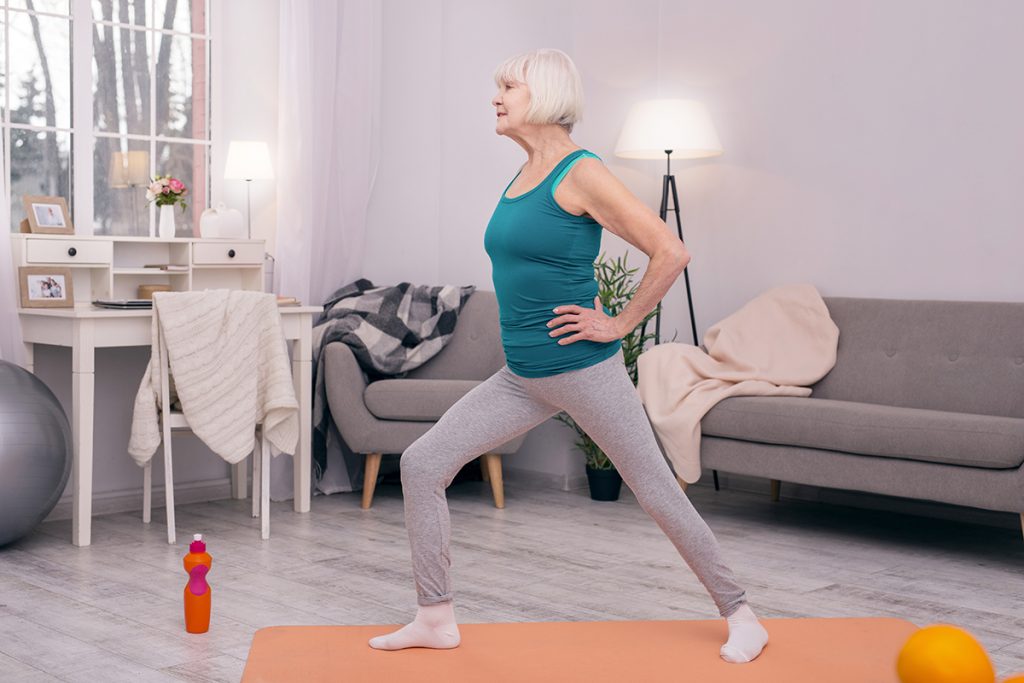In Part 1, we discussed how a thought becomes an action, and the disconnect in Parkinson’s Disease, as well as how a Fitness Professional do to improve brain and body connection.
For those living with Parkinson’s, the three Activities of Daily Living (ADLs) considered to be most difficult to perform are:
- Rolling over in bed
- Getting out of a vehicle
- Working through a freeze episode while crossing over a threshold between rooms.
I have provided a list of exercises to complement these ADLs as well as a “Practice Option” that combines the exercises listed.
Considerations
- Remember to begin with the most basic of movements until the client can properly and safely execute the exercise.
- Care partners of wheelchair-bound clients need to be instructed on how to safely assist loved ones without causing injury to either person. Please refer the client to an Occupational Therapist if needed.
Activity of Daily Living: Rolling over in bed
Exercises
- Bridges
- Push-ups or chest press
- Tricep extension
- Rows
- Glute squeezes (for chair bound)
- Lateral Step with torso rotation using a tube
- Side Planks/ Prone Plank
- Clamshells
Advanced Practice Option: Have the client lay on his or her back. Take the right leg and swing the leg over the left leg and move into the side plank position and hold for 5 counts. From there roll to a prone plane OR bird dog position. Reverse the exercise to practice returning to the supine position.
Assisted Practice Option: If lying down is not an option, have the client sit in a chair. Have the client hold a tube with both hands in front of them. Trainer provides tension from the side and the client maintains the isometric hold while picking up one leg and moving it out to the side and bringing it back in like a seated jumping jack.

Activity of Daily Living: Getting in/out of vehicle
Exercises
- Rows (add a diagonal step/lunge)
- Squats/Lunges
- Sit to Stand drill (include single leg version)
- Bridges
- Clamshells (or any abduction work)
- ½ Warrior step / ½ Gong arms
- “Step over the Fence” ( lift left knee and step laterally over the “fence” followed by the right knee and then reverse the movement)
- “Jazz Hands” (improves ability to reach)
- Hip circles
- Bob-n-weave (or lean left/right if needed)
- Side planks or oblique bend
- Tricep/Biceps (add lower body exercise)
Advanced Practice Option: (Stand with chair next to left leg). Place a hurdle next to chair to act as the “floorboard” of the car. Client will stand alongside the “car”. Client will then lift the left knee and hold for 3-5 counts then step “over the fence”/bob-n-weave” to get into the car. Reverse the motion to practice getting out of the car. Repeat on the other side.
Assisted Practice Option: (Begin in a chair and with a short hurdle or object for them to “step” over). Client is in the chair and reaches right arm out as if opening the car door (jazz hands). Client then comes back to center and picks up the right knee and steps over the hurdle and turns foot to the right (½ warrior/ ½ gong) as the entire body turns to the right. Left foot follows the right foot and steps over the hurdle. Once the feet are facing the right, have the client do a full or partial Sit-to Stand drill. Reverse the motion to practice getting into the car.
Activity of Daily Living: Working through a “freeze” episode
Exercises
- Obstacle courses
- Stop and start gait drills
- Walk and turn head right and left
- Walk slow then fast then slow etc
- Walk and at cue, stop and turn
- Visual drills
- Lateral steps 5x then walk forward
- Walk to a song with a strong beat
- Criss-Cross Applesauce
*If client freezes at room threshold, emphasize that they want to look straight ahead and not down.
These three ADLs are just a few of the frustrating tasks people living with Parkinson’s Disease deal with each and every day. Fitness Professionals can make a real difference in someone’s life if they will take the time to consider how movement works, where it can go wrong, and what to do to help it go right again. Imagine the success your client will experience during a session and throughout the day as they tackle ADLs with minimal effort! I can tell you this, their level of confidence will soar and the future will be something they look forward to.
Work with Parkinson’s Clients and Change Lives!
Working with Parkinson’s clients is an extremely rewarding experience. Check out Colleen’s course, Parkinson’s Disease Fitness Specialist to get started.
Colleen Bridges has worked for nearly 17 years as an NSCA Certified personal trainer, group exercise instructor and fitness consultant and as an independent contractor for Nashville’s first personal training center, STEPS Fitness. Her passion for understanding the body in sickness and in health, and how it moves, as fed her interest in and enhanced her talent for working with senior adults, especially those living with a neurological disorder such as Parkinson’s Disease.
Renee Rouleau is a Clinical Research Coordinator for the Department of Neurology at Vanderbilt Movement Disorder. Her research primarily focuses on the glymphatic system, a proposed waste-clearance system in the central nervous system in different neurodegenerative disorders such as Parkinson’s Disease (PD) and Alzheimer’s Disease (AD).


